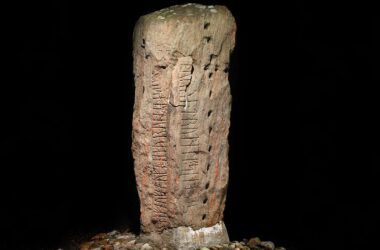Illustration of a Homo erectus child with her mother in the Ethiopian highlands
Diego Rodriguez Robredo
As early as 2 million years ago, ancient people were occupying the Ethiopian highlands. The discovery of a fossilised jawbone belonging to Homo erectus in this area provides the earliest evidence of hominins occupying such high-altitude regions.
According to Margherita Mussi of the Rome-based Italo-Spanish Archaeological Mission at Melka Kunture and Balchit, “a third pole for human evolution in Africa” can be found in the highlands. Numerous hominin fossils have been discovered in eastern and southern Africa, however none have been discovered in upland regions as of yet.
The lower jawbone of an infant was discovered in 1981 at a site called Garba IV in the Ethiopian highlands and was reexamined by Mussi and her colleagues. Garba IV is a part of the Melka Kunture network of sites. The jawbone has been dubbed “Little Garba” by Mussi.
An earlier species of the genus Homo, which includes both our own Homo sapiens and other extinct groups, was previously recognised as the source of the jawbone. However, conclusive species identification was not feasible.
Synchrotron imaging was employed by Mussi and her team to examine teeth that had not yet erupted from Little Garba’s jawbone. The teeth were compared to teeth from other hominid species. According to Mussi, “the teeth are a very good marker,” allowing them to definitively state that “this is indeed an early Homo erectus.”
Mussi’s team redated the Garba IV location in a prior study that was published in 2021. Sediment has accumulated over time to form these layers. Researchers discovered records of past changes to Earth’s magnetic field in the sediments, which they compared to other records found in other locations. They infer from this that Little Garba is 2,000,000 years old. One of the oldest examples of Homo erectus discovered to date.
It’s possible that the species originated there. Mussi argues that it is unclear if Homo erectus originated at a lower elevation and then migrated to higher ones, or whether it developed in its current location.
Researchers also reexamined stone tools unearthed in Garba IV’s sediments. Between 2 and 1.95 million years ago, there was supposedly a change from the simpler Oldowan tools to the more complex Acheulean tools. Acheulean tools needed more forethought and effort to create, but they also allowed for a greater variety of diets.
Mussi draws connections between these pieces of evidence to propose that H. erectus people in the highlands were forced to adapt to their environment by creating new types of stone tools.
According to Clément Zanolli of the University of Bordeaux in France, the case for identifying Little Garba as H. erectus is strong. Since there aren’t too many Oldowan tools in the earlier levels, he is less convinced by the transition from Oldowan to Acheulean.
To quote Zanolli, “the most exciting aspect” of the study is its highland setting. We know of no older [hominin] that made it to the upper plateau of Ethiopia than this one,” he says. “for now it’s the earliest,” yet it’s likely that even earlier hominins will be discovered in the area during future investigations.
According to Zanolli, the difficulty of breathing at Garba IV’s altitude (about 2,000 metres) is minimal. Although the highlands would have been colder, they might have been more habitable because the lowlands were desert. “In this high-altitude environment you have more trees, more bushes, and probably more animals,” he explains. Finding food and staying alive is probably less of a struggle there.
H. erectus was the first hominid to spread out of Africa, leaving the continent around 1.8 million years ago to settle in Dmanisi, Georgia, and maybe 1.3 million years ago to settle in Java, Indonesia. Mussi speculates that his upbringing in Ethiopia’s mountainous regions served him well. Homo erectus, she argues, could have survived in other, cooler locations further from the equator if it had adapted to this one.
FAQs
- Where was the Homo erectus jawbone discovered?
- The jawbone was found in the Ethiopian highlands at a site called Garba IV.
- What significance does the jawbone hold in understanding human evolution?
- The discovery provides the earliest evidence of hominins occupying high-altitude regions, suggesting that Homo erectus might have originated or adapted in such environments.
- How did researchers determine the age of the jawbone?
- Researchers redated the Garba IV location using sediment layers and records of past changes to Earth’s magnetic field, estimating the jawbone to be around 2 million years old.
- What transition in stone tool technology is discussed in the study?
- The study discusses a transition from the simpler Oldowan tools to the more complex Acheulean tools, which might have been an adaptive response to the highland environment.
- Why is the highland setting of the discovery considered significant?
- The highland setting is significant as it challenges previous beliefs about early hominin habitats and suggests that these regions might have offered more resources and a more habitable environment compared to the lowland







